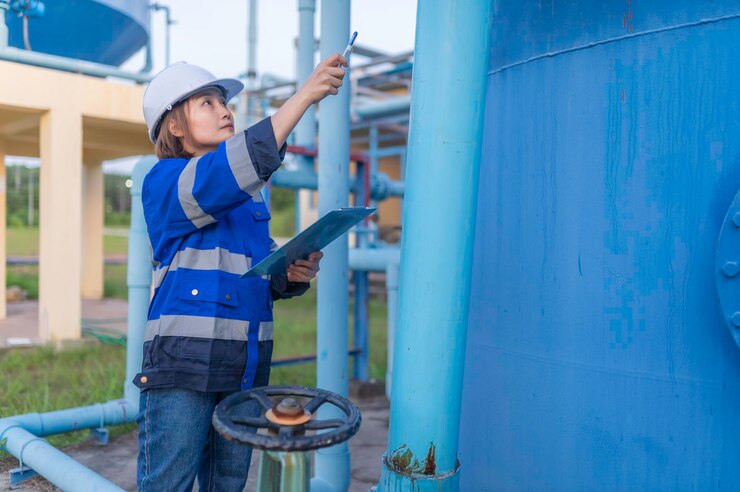
Above-ground storage tanks are integral to the operations of diverse industries, such as agriculture, mining, oil & gas, and water & wastewater management. Their reliable performance is contingent on their structural integrity, making routine tank inspections crucial for asset management and maintenance. Furthermore, regular inspections enable organisations to ensure compliance with industry regulations while safeguarding environmental and personnel safety.
In this comprehensive guide, we delve into the world of above-ground storage tank inspections by covering various inspection methods, their relevance in different applications, and the crucial factors to consider when planning an inspection regime. By understanding the importance of these inspections and the expert-driven processes involved, you can take control of your facility’s storage assets, maintain compliance, and make informed decisions that ultimately contribute to your business’s ongoing success.
Ready to unlock the potential of professional tank inspections and embrace a proactive approach to maintaining your storage assets? Our experienced team is dedicated to helping you navigate the complexities of tank inspections, providing tailored solutions, and assisting you in developing a tailored inspection regime that aligns with your facility’s unique requirements.
The Importance of Regular Tank Inspections
Conducting routine inspections of your above-ground storage tanks is a vital aspect of asset management, offering several benefits:
1. Asset Integrity: Regular inspections help identify and address structural issues, such as corrosion, leaks, or material degradation, ensuring the long-term performance and integrity of your tanks.
2. Safety: Inspections play a crucial role in ensuring the safety of both facility personnel and the environment by detecting potential hazards and enabling proactive measures to mitigate any risks.
3. Regulatory Compliance: Tank inspections ensure compliance with industry standards and regulations. Regularly scheduled inspections are often mandated by authorities to fulfil safety and environmental requirements.
4. Operational Efficiency: By identifying and addressing tank-related issues, inspections contribute to your facility’s overall operational efficiency by minimising downtime, reducing maintenance costs, and maximising asset lifespan.
Above-Ground Storage Tank Inspection Methods
Various inspection methods are available, each offering unique advantages depending on the specific requirements of a given application:
1. Visual Inspections: These inspections involve a thorough visual examination of the tank’s exterior for signs of damage, corrosion, or other issues. Visual inspections are often conducted as an initial assessment to identify any areas that may require further investigation using more advanced techniques.
2. Ultrasonic Testing (UT): UT uses high-frequency sound waves to measure the thickness of the tank’s walls and detect potential signs of corrosion or other damage. UT inspections can provide valuable insight into the tank’s structural integrity and identify areas that may require maintenance or repair.
3. Magnetic Flux Leakage (MFL): MFL is an advanced non-destructive testing technique that uses magnetic fields to detect defects or corrosion in ferromagnetic materials, such as steel storage tanks. MFL inspections offer a detailed assessment of the tank’s structural integrity and can identify areas where further investigation or maintenance may be necessary.
4. Remote-Operated Vehicle (ROV) Inspections: ROV inspections involve the use of sophisticated underwater vehicles equipped with cameras, sensors, and other tools to inspect tanks that are submerged or contain fluid. These inspections offer a safer, more efficient alternative to traditional diving or draining methods.
Factors to Consider When Planning Tank Inspections
When planning your tank inspection regime, consider the following factors to ensure optimal coverage and results:
1. Inspection Frequency: Determining the appropriate frequency of inspections depends on factors such as tank usage, material, size, and age. Industry-specific regulations may also dictate minimum inspection intervals.
2. Tank Accessibility: Ensure that proper access points are available, including manways and confined space entry points, to facilitate efficient and thorough inspections.
3. Inspection Method: Choose the most suitable inspection method based on the specific requirements of your tank and industry. Consider the size, material, and operational conditions of your tanks when making this decision.
4. Personnel and Training: Engage trained, qualified, and certified inspectors to perform the inspections, as their expertise ensures accurate results and reliable recommendations for any necessary maintenance or repair works.
Documentation and Recordkeeping
Maintaining detailed and accurate records of all tank inspections is vital for several reasons:
1. Compliance: Inspection records are essential for demonstrating compliance with industry regulations and may be required to provide during audits or assessments by regulatory authorities.
2. Data Analysis: Inspection records allow you to analyse trends in your tank’s performance and integrity, enabling proactive maintenance strategies and informed repair or replacement decisions.
3. Asset Management: Documenting inspections assists in developing comprehensive asset management plans that take into account the condition, maintenance history, and performance trends of each of your facility’s storage assets.
Conclusion
Regular above-ground storage tank inspections are a critical component of asset management, ensuring the reliable performance, safety, and regulatory compliance of your facility’s storage systems. By understanding the various inspection methods available and the key factors to consider when planning an inspection regime, you can take control of your facility’s storage assets and make informed decisions that contribute to your business’s ongoing success.
If you’re ready to implement a robust inspection strategy tailored to your unique needs and industry requirements, our expert team at ATM Tanks is here to help. We specialise in providing comprehensive, customised tank inspection services that cater to your specific requirements, ensuring the optimal performance, safety, and compliance of your valuable storage assets. Contact us today to learn more about our expert-driven solutions.
- How to Fix Leaks in Your Water Storage Tanks - December 14, 2025
- Effective Techniques for Thorough Tank Cleaning - December 14, 2025
- The Benefits of ROV Tank Inspections for Maintenance - December 14, 2025






